Top 20 Caravanserais in Iran that will WOW You
A location for caravans (a group of travelers) to stop and refresh after long days of traveling on trade routes, caravanserais are one of Iran's most significant and magnificent historical monuments.
Travelers ate and drank together while leaving their horses at the caravanserai's stables and enjoying some peace. These caravanserais, erected by several kings, are widespread along Iran's congested roadways; some have now been converted into traditional hotels. The equivalent of today's hotels was the caravanserais in the past. For this reason, these places held high importance in ancient times.
In this post from Eavar, we review the history of caravanserais, the most significant Iranian caravanserais still in existence, and provide 20 examples.
Iranian Caravanserai Architecture
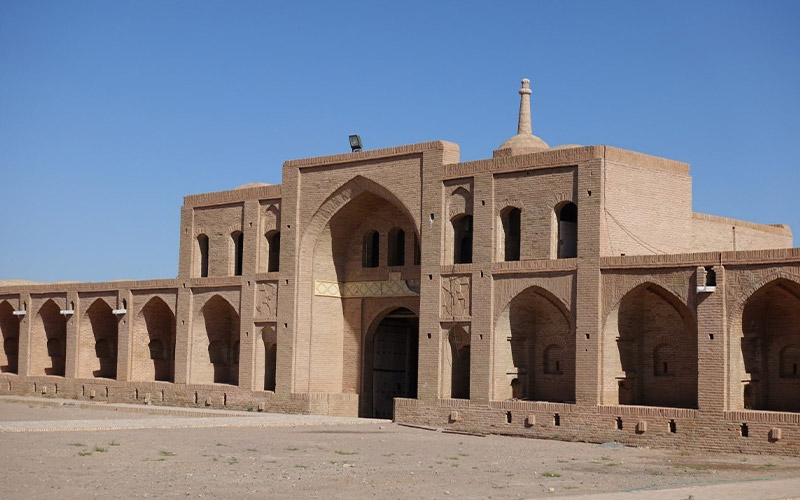
Iranian caravanserai traditional architecture may be researched and analyzed from various angles, such as typology and physical components, materials, design and map, and the period of creation.
The following three construction typologies can be used to categorize caravanserais in Iran:
- Fully enclosed caravanserais, which are more common in mountainous regions.
- Caravanserais without yards, which are mainly constructed along the Persian Gulf.
- Courtyard caravanserais, explicitly designed for Iran's arid regions.
The most beautiful caravanserais in Iran are those with courtyards, which are divided into several categories:
- Round caravanserai
- Polygonal Caravanserai
- Rectangular caravanserai with two porches or four porches
Caravanserais had a large and heavy wooden entrance door, which allowed the entry of animals like horses or camels with bulky loads. Usually, there is a porch at the entrance. Some porches have a simple half-dome roof, while others have more artistic designs. Typically, the entry porch has two stories. In the second story, Shah Neshin was constructed as housing for the elderly and unique individuals. These areas were also utilized for the night watch. The remaining structures of caravanserai were situated on a platform or row higher above the ground level and typically featured one story.

The stable was often situated halfway between the rooms and the caravanserai's exterior walls. The stables were also situated in the second yard, near the guest rooms, or in the front yard.
In caravanserais with courtyards, the apartments were distributed around the space. The interface between the rooms and the yard was a covered porch that accommodated various activities such as residents' gatherings, summer dormitories, temporary storage, etc.
The bedrooms in the caravanserai were tight areas with brick flooring. A well or water basin for cooking and washing was situated in the center of the caravanserai courtyard.
The city's caravanserais were less fortified and lacked towers and walls. They usually did not include stables because every city had one or more places for horses and camels. The Parthians' design for enclosed houses with a central courtyard, from 247 B.C.B.C., is reflected in these caravanserais.
Caravanserais lost their primary function and importance during the middle of the 19th century and were reduced to serving as a location for inexpensive items, parking, and storage.
| Discover: Best 5 Star Hotels In Iran to Stay in 2023 + Pics
Caravanserai History
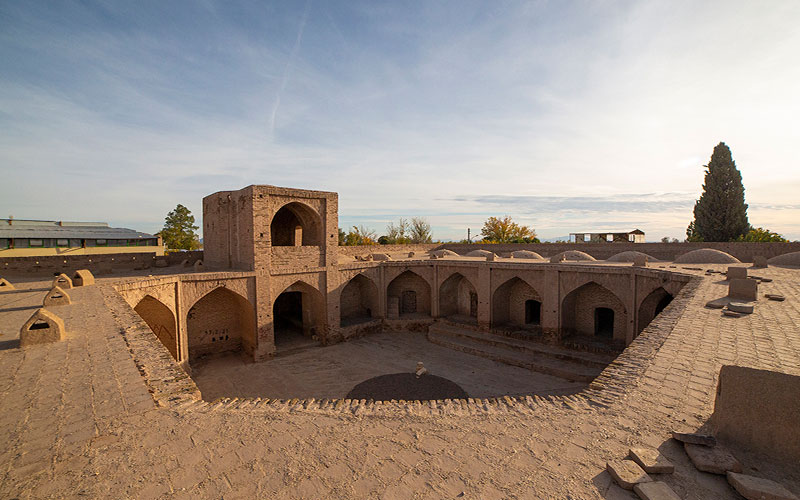
The history of caravanserais in Iran starts from the Achaemenid era (550 BC). Caravanserais in Iran during the Parthian era (240 BC) were also considered one of the most important centers in the country's logistics. Still, few traces of the construction of caravanserais in these two periods can be investigated. The oldest caravanserais in Iran, whose buildings still stand, dating back to the Sassanid rule in Iran (224 AD).
Caravanserais have served as a secure resting area for travelers and their horses from the Achaemenid empire (550 BC) through Iran's Qajar era (19th century).
| Suggestion: Khanat Caravanserai - Where History Meets Modernity
Caravanserai Origin

The first inter-road space known in history was the Chaparkhaneh, where government couriers (Chapars) could stop and swap their worn-out horses for new ones. The Chaparkhaneh system, considered one of the essential innovations of its time, was established for the first time in the Achaemenid Empire in Iran (Persia). The letters were delivered using this approach as quickly as feasible.
Over time, Chaparkhanehs changed into caravanserais, a shelter and a place to rest for commercial caravans and government couriers.
Silk Road Caravanserais
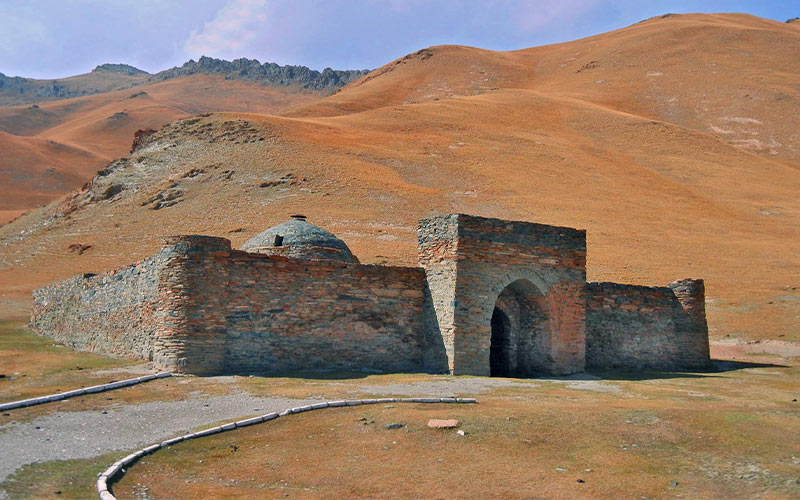
During the Achaemenid era, Chaparkhanehs were constructed along the Silk Road (the most important trade route of the ancient world). The development of these buildings into caravanserais throughout time led to the emergence of the Silk Road caravanserais.
Iranian Caravanserai Importance
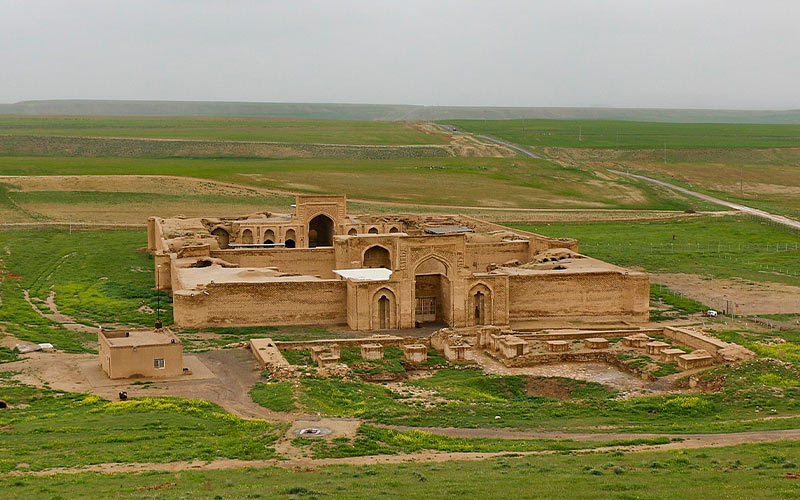
The Persian Caravanserais in Iran enabled travel and transport operations in deserts and finally made intercontinental cultural pathways feasible through various tactics of adapting to, using and renovating natural environments, including the effective development of desert regions. As a result, it serves as a superb illustration of how people may engage with nature for the benefit of long-distance travel and communication.
In addition to their aesthetic and artistic value, Persian caravanserais significantly impact social and cultural elements. In addition to providing a haven for travelers to relax, caravanserais served as a meeting place for individuals of many nationalities and cultural backgrounds to exchange knowledge and views.
This station has long served as a hub for discussing and exporting cultures, religions, and ideas nationally and worldwide by being tangibly or directly connected to historical occurrences, existing customs, concepts, or literary and creative creations of remarkable worldwide value.
Top 20 Caravanserai in Iran You Should Visit
Following, we list some of the most magnificent caravanserais in Iran that are still standing. Some of these caravanserais are currently used as hotels.
1. Deyre Gachin Caravanserai
Location: Qom province, Qom city, 70 km Qom-Garmsar highway, Ali Abad village
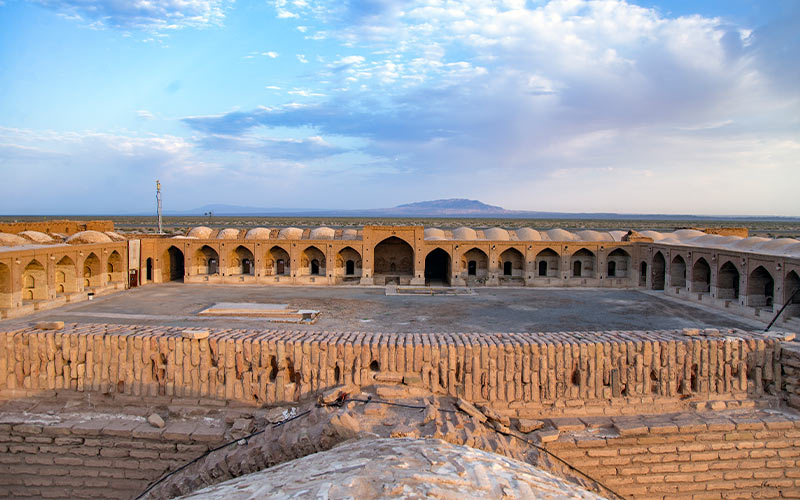
Deyre Gachin CaravansaryIn the middle of Kavir National Park, on the ancient road from Ray to Qom, lies a caravanserai named Deyre Gachin. One of Iran's largest caravanserais, Deyre Gachin, has earned the title "the mother of Iranian caravanserais" due to its distinctive features. Due to a plaster dome that once topped the structure—which is no longer present—it was known as Deyre Gachin (in Persian, Gach means plaster). The "Deyr Road," a historic route to Isfahan, passes by this caravanserai. Deyre Gachin was abandoned after Amin-Ol Sultan switched the route from Tehran to Qom from Deyr road to Hassan Abad road. Because the historical heritage authorities disregarded this work, locals used it to house cattle, which destroyed a significant portion of it. However, today saw the rebuilding project's beginning.
Deyre Gachin Caravanserai Time Period
The history of the Deyre Gachin caravanserai dates back 1,750 years to the time of Ardeshir Sassanid. During the Seljuk era, the caravanserai's structure was renovated, and four porches and stables were constructed. Additionally, the previous bricks were integrated with the new mortar in this period. The Deyre Gachin caravanserai underwent extensive renovation during the Safavid era, and the towers, outside walls, and current entrances were erected. The outside of the caravanserai was where most of the Qajar period restorations and building projects were completed.
Consequently, the following periods may be used to describe the history of the Deyre Gachin caravanserai:
- the Sasanian era
- the Seljuk era
- the Safavid era
- the Qajar era
2. Miyandasht Carvanserai
Location: Miandasht Caravanserai is located in Semnan province, 40 km from Miami city, and has a semi-arid climate.
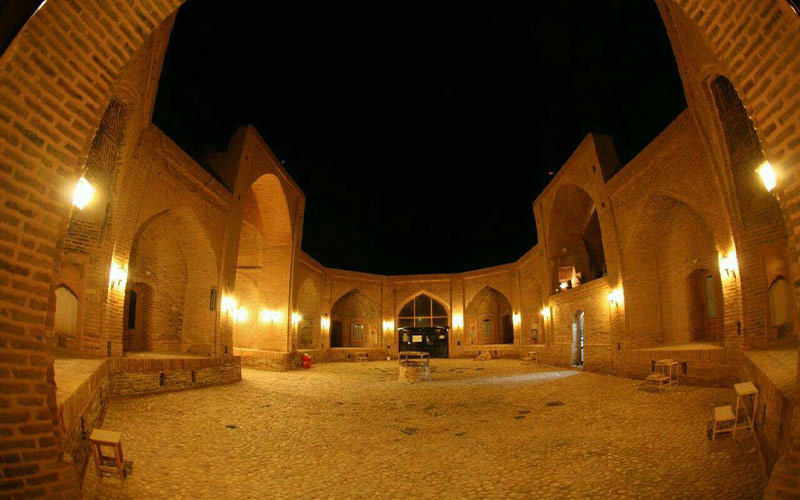
The largest caravanserai complex in Iran, the 400-year-old Miyandasht caravanserai, is 40 kilometers from Miami, Iran.
The Chaparkhaneh, telegraph house, and water reservoirs are a few of the caravanserai of Miyandasht's ancient buildings. Today, it can accommodate a maximum of 200 visitors by offering the comforts of home and having 15 rooms with two beds. The toilet and bathroom are public and are found in the basement of the complex; the bathroom in the rooms of this caravanserai needed to be constructed to retain the traditional style.
Miyandasht Caravanserai period
Three caravanserais make up this complex. There were three caravanserais in use at the time, two from the Qajar and one from the Safavid periods, which received 2 thousand passengers at that time. Malek o' Shoara Saburi, the father of Malek o' Shoara Bahar, wrote the history of the construction of the middle caravanserai in poetry, which is engraved on the front entrance of the structure.
3. Shah Abbasi Bisotun Caravanserai
Location: Kermanshah province, 30 kilometers northeast of Kermanshah city, is the historical city of Bisotun.
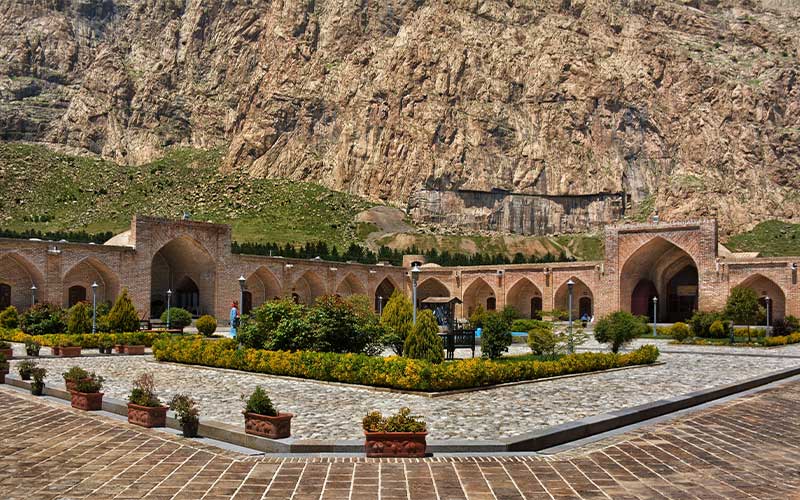
The Bisotun mountain and Achaemenid Dariush's well-known inscription make Bisotun City renowned. A five-kilometer-long by three-kilometer-wide region contains the historical and cultural complex of Bisotun. This collection includes artifacts dating from the Paleolithic to the Qajar era and has been added to the UNESCO World Heritage List. Among these creations is the Bisotun caravanserai, perched on a hilltop overlooking a vast, verdant plain.
One of Kermanshah's must-see locations is the Bisotun Caravanserai, also known as Shah Abbasi Caravanserai, which is situated in the city's historic and cultural district. Most people pass up the chance to see the Bisotun Caravanserai since it is practically at the westernmost point of the Bisotun historical sites.
Bisotun Caravanserai Time Period
Shah Abbas I of the Safavids gave the order to construct the Bisotun Caravanserai. This caravanserai appears to have been built under the rule of Shah Soleiman and the chancellery of Sheikh Ali Khan Zanganeh, based on the inscription placed in the structure by Shah Soleiman Safavi. During the rule of Nasereddin Shah Qajar, Haji Jafar Khan Memarbashi Esfhani renovated this location.
4. Maranjaab Caravanserai
Location: Isfahan province, 50 km northeast of Aran and Bidgol, Maranjaab desert.
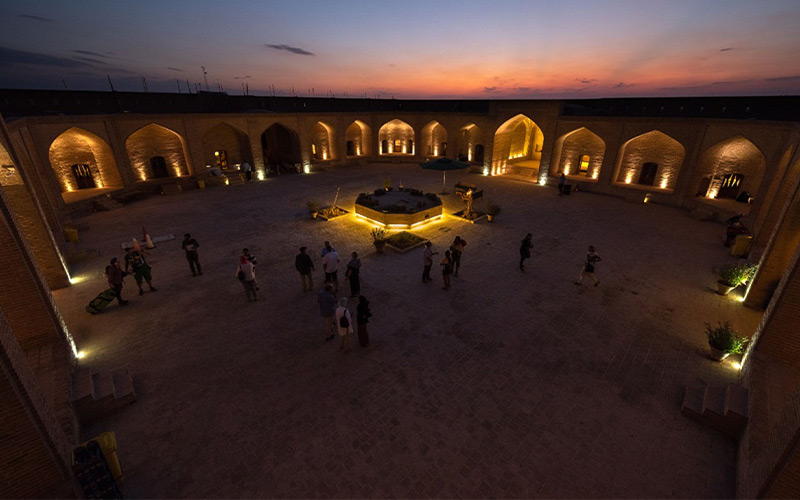
The Maranjaab Caravanserai is situated in "Band Rig," one of Iran's most well-known and substantial sabulous areas. This location used to be where rivers and streams crossed permanently and seasonally, and even in the spring, it was thought to be quite dangerous owing to the movement of floodwaters. Now those floods are no more, and the Band Rig becomes stunning with vegetation in the spring. Additionally, a distinctive image is produced when the wind moves the dunes.
The caravanserai structure draws attention from a distance between the lake and the dunes, looking like a wonderfully painted picture. Thus, it is not surprising that landscape photographers or filmmakers come here to set up scenes for historical events.
Maranjaab Caravanserai Time Period
According to the succession of caravanserai building projects that Shah Abbas carried out on the significant and popular Silk Road routes, the Maranjaab Caravanserai was built in 1603 on a hillside near the freshwater spring and Aqualand south of the salt lake. This caravanserai served as a rest stop for travelers and was in charge of guarding the major highway leading from the capital (Isfahan) to the city of Mashhad.
5. Qasr-e Bahram Caravanserai
Location: Semnan Province, 123 km south of Garmsar, northeast of Salt Lake.
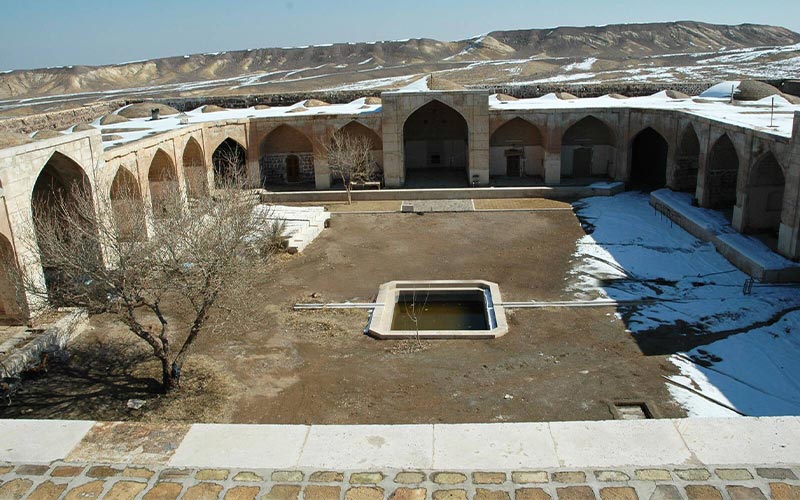
Qasr-e Bahram Caravanserai is one of Semnan's historical landmarks. The caravanserai is still utilized as a stopover and rest area for those interested in seeing the starry night sky. The Environmental Protection Organization of Iran protects several plants and animal species in the desert lands around this caravanserai, also known as Kavir National Park. Tourist groups often desire to visit desert areas, and staying in this historical caravanserai multiplies this desire. Qasr-e Bahram Caravanserai is the ideal location for those seeking peace in the desert because it is situated directly in the center of the protected region of the Kavir National Park, and no people are living there.
This location is perfect for astronomers, astrophotographers, and sky enthusiasts. One of the most well-liked locations to observe the starry sky during the pitch-black desert night is Qasr-e Bahram Caravanserai. Many travelers decide to stay in this caravanserai Since they may enjoy watching and taking pictures of the desert's starry sky,
Qasr-E Bahram Caravanserai period
Shah Bahram Sasanid or Bahram Gour constructed the Qasr-e Bahram palace during the Sassanid dynasty. Shah Abbas Safavi later renovated it and turned it into a caravanserai.
6. Ahovan Caravanserai
Location: Shah Soleimani Ahovan Caravanserai (Ahovan Stone Caravanserai) is located 42 km east of Semnan in Ahovan village.
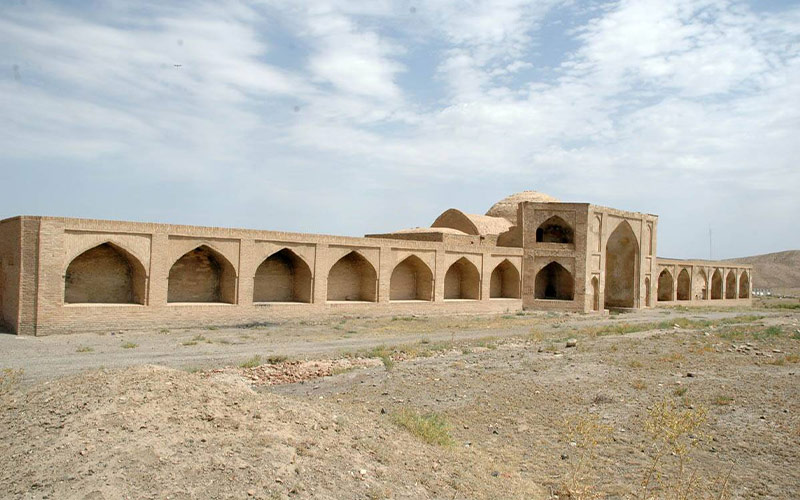
The Ahovan area, east of Semnan City, is where you can find the Ahovan Stone Caravanserai. This caravanserai's structure is constructed of stone and mortar. The 11th century saw the construction of this caravanserai. The Shah Abbasi Ahovan Caravanserai is a nearby structure constructed close to the previous caravanserai during the Safavid era.
The creativity of Iranian architects may be seen in the Ahavon stone caravanserai, where a hall was designed to keep the cold from entering the apartments. This innovation continues to this day, inspiring many engineers.
Ahovan Caravanserai Time Period
As said before, this caravanserai was constructed in the eleventh century. During the Safavid and Ilkhanid eras, Ahovan Caravanserai was renovated and used.
7. Madar Shah (Murchehkhort) Caravanserai
Location: Isfahan province, Shahinshahr and Mimeh counties, Murchehkhort. This caravanserai is located on the left side of the Isfahan-Tehran road, 45 km northwest of Isfahan.
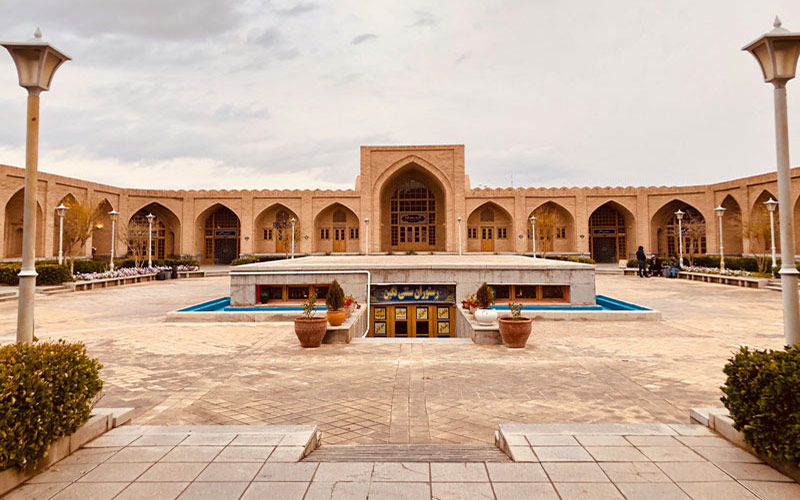
One of the cultural centers of the province of Isfahan is the Mader Shah Caravanserai, also known as the Morche Khort Caravanserai and the Shahinshahr Abbasi Caravanserai. With its recent renovations and preservation of aesthetic elements and architectural characteristics, this complex is regarded as one of Iran's most prosperous historical structures.
Madar Shah Caravanserai Time Period
Madar Shah Caravanserai was built during the Safavid era. The reason for this name is the command of the mother of one of the Safavid kings to build this building (Madar Shah means the king's mother).
8. Titi Caravanserai
Location: Titi Caravanserai is located in Gilan province, 15 km from Siahkal road to Deylaman.
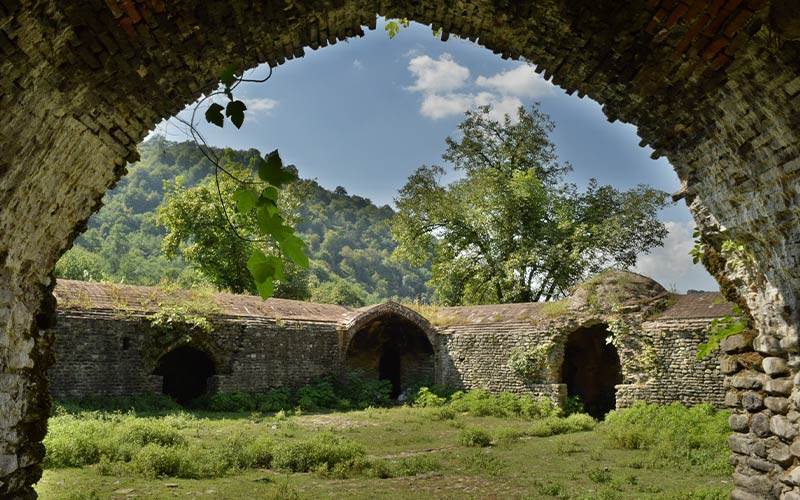
River stones and mortar were used in the construction of Titi caravanserai. Those going from Siahkal and Deylaman to Taleghan stayed in this caravanserai, which was established by lady Titi, the aunt of one of the Safavid kings.
Titi means blossom in the Gilaki language, one of the subgroups of Persian. Thus Titi caravanserai means Blossom caravanserai. This name is appropriate given that the view from this caravanserai is one of a lush, flower-filled caravanserai, which can be seen if you visit this historic structure.
Titi Caravanserai Time Perioid
The Titi Caravanserai was built during the Safavid dynasty.
9. Zein-O-Din Caravanserai
Location: Yazd province, Mehriz city, Mehriz-Anar highway, 60 km of the Yazd-Kerman road.
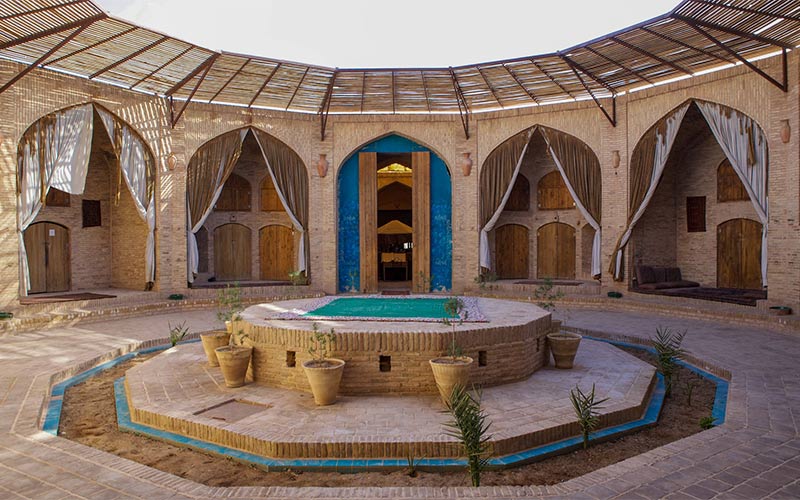
Zein-o-din Caravanserai, One of the most exquisite caravanserais in the whole world, stands out like a jewel in the middle of the desert. One of the few circular structures left in Iran and on the Asian continent along the Silk Road is this building.
Currently, visitors can stay at Zein-o-din Caravanserai; this offers an opportunity to travel back in time and build everlasting memories.
Zein-O-Din Caravanserai Time Period
Shah Abbas Safavi gave the order to construct the Zein-o-din Caravanserai, designed by Mohammad Sultan Yazdi (the architect and designer of the beautiful and unique Ganj Ali Khan complex in Kerman). This caravanserai in the heart of the desert and the ancient city of Mehriz is more than 400 years old, and some call it Robat Zein-o-din.
It's fascinating to know that Zainuddin Caravanserai is one of the 999 caravanserais Shah Abbas Safavi constructed in Iran. The only Iranian circular edifice on the Silk Road, this caravanserai was constructed in honor of the meeting between Shah Abbas and Zein-o-din Ganjali Khan, the ruler of Kerman, in the 16th century A.D.
10. Abouzeidabad Caravanserai
Location: Kashan city, Abouzeid Abad, Dolat Square, Safavi St
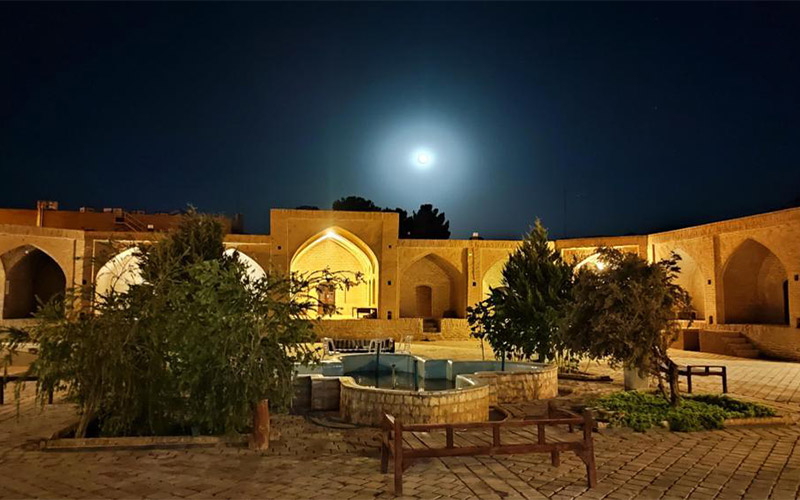
The square-plan Abouzeidabad caravanserai, constructed in the city of Abouzeid Abad in the manner of caravanserais with four porches, is one of the Safavid period caravansaries. Because of its location on the main route connecting Kashan, Yazd, and Isfahan, this caravanserai was quite significant.
Currently, the caravanserai is prepared to welcome visitors to the Abrooz Hotel. You may spend the night in this historic caravanserai and have a wonderful experience sleeping in the desert.
Abouzeidabad Caravanserai Time Period
Abouzeidabad caravanserai is a remnant of the Safavid period.
11. Shah Abbasi Caravanserai & Museum of Neyshabur
Location: This caravanserai is located on the southern border of Imam Khomeini Street and near Khayyam Square in the eastern part of the Neyshabur city center.
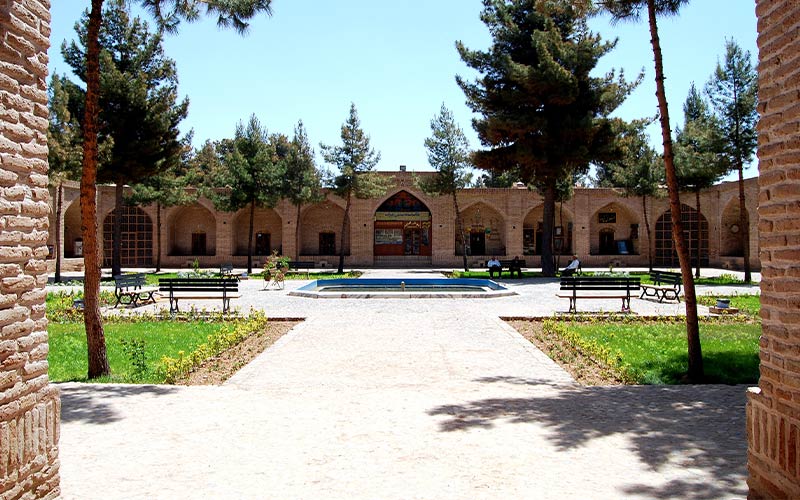
The Shah Abbasi Caravanserai of Neyshabur, also referred to as "Shah Abbasi Robat," is one of the historical structures and attractions of the Razavi Khorasan province in Neyshabur city. Initially, it was situated outside the city gate, but due to the city's expansion, it is currently situated in the city's center. The original location of this caravanserai was beyond the moat of the ancient city and the fence around the Mashhad gate.
Currently, the "Nishabur Museum," which has three sections—archaeology, anthropology, and a special section—is housed in the pavilions on the caravanserai's eastern side. Historical artifacts are shown in the archeology department, including coins from pre-Islamic times to the Timurid era, clay vessels from historical and Islamic eras, metal and glass vessels, and stone artifacts. Aspects of the region's people's everyday lives are depicted in the anthropology section. The special section features artifacts like statues from historical times and earlier, a replica of Neyshabur's old city during the Timurid era, the imitation human rights cylinder written in cuneiform by Cyrus the Achaemenid, several historical tombstones, a collection of medals and edicts from R.I.P. Pahlavan Yaqub Ali Shurvarzi, several historical inlaid wooden shrines.
Shah Abbasi Caravanserai of the Neyshabur period
The caravanserai of Shah Abbasi Neishabur is one of the buildings from the Safavid period, which today is used as a museum and selling handicrafts.
12. Khanat Caravanserai in Tehran
Location: Khanat Caravanserai is located in Tehran, north of Shoush Square, south of Molavi intersection, Amin ol-Soltan Square, Saheb Jam Street.
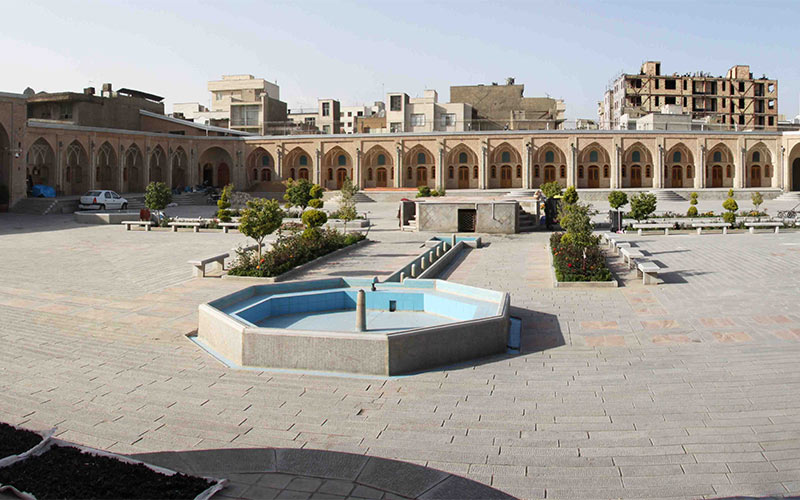
Tehran was located at the intersection of the axes of Qom, Khorasan, Mazandaran, Qazvin, Gilan, and Saveh. Since ancient times, it has been renowned for its crucial political, commercial, administrative, and religious significance. For this reason, this city has historically seen the construction of various caravanserais. The Khanat Caravanserai is one of these antique caravanserais that is still surviving.
The Khanat Caravanserai is the biggest in Tehran. It has a roughly 10,500 square meters, 70 cells inside the courtyard and four bazaars outside the cells. The door to the building is six meters high and has 40 studs. Up to now, Khanat Caravanserai has continued to be in use. However, businesses and traders, particularly wholesalers of nuts and dried fruits, continue to operate in the nearby cells even if caravans no longer remain there. A corner of this caravanserai also houses the Khanat traditional restaurant, which has a lovely setting frequented by many Tehran residents who come for lunch and to see the caravanserai.
Khanat Caravanserai Time Period
The building of Khanat Caravanserai has been dated to the latter part of Nasereddin Shah Qajar's rule, or around 1882, based on its architectural elements. Despite the lack of evidence on the building's precise construction date, this caravanserai may be seen on the historical map of Tehran. Najm ol-Molk created this map in 1891.
13. Robat Sharaf
Location: This caravanserai is located 45 km from Sarakhs city in Razavi Khorasan province.
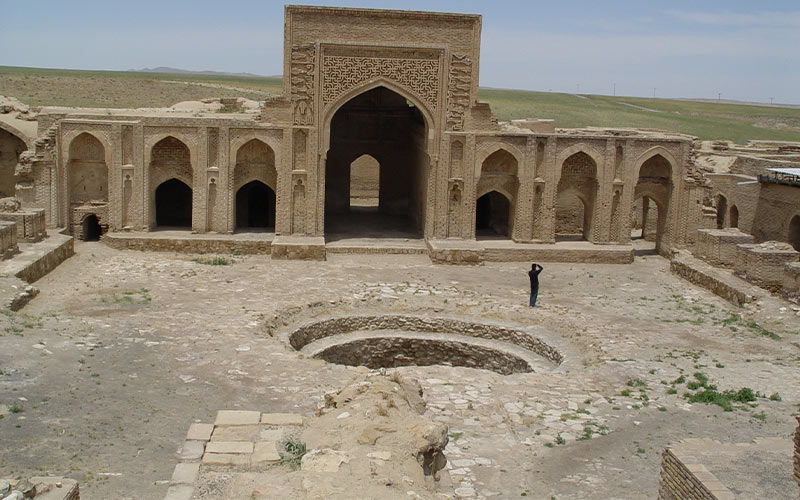
In terms of Iranian architecture, the Robat Sharaf caravanserai is one of the most priceless Seljuk-era structures. This caravanserai was created and constructed in the Razi architectural style, one of the traditional Iranian architectural movements and regarded as an Iranian architectural renaissance. This caravanserai is open for tours as a historical landmark even though it is no longer being utilized as a place of residence.
Robat Sharaf period
The presence of several inscriptions in this caravanserai demonstrates that the building's construction belongs to the early 12th century, which corresponds to Iran's Seljuk era of dominance.
14. Dehnamak Caravanserai
Location: Dehnamak Caravanserai is located in Dehnamak village, 25 km from Aradan city and 75 km from the provincial capital (Semnan city).
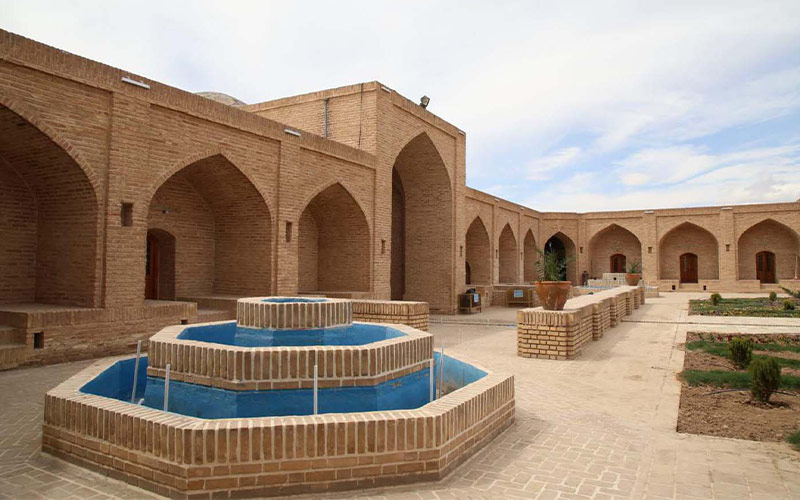
Another illustrious and historic caravanserai of Iran is Deh Namak, situated in Semnan Province. Four porches, 24 rooms, and a king's dwelling chamber make up this caravanserai, which gives the structure a lovely aesthetic. We may also highlight the camel shelter, the four-night watch towers erected on the caravanserai's outside walls, and the docks at each of its four corners.
You may stay at this caravanserai, which is still in use as an ecotourism house. The 23 rooms of the Shah Abbasi Deh Namak Caravanserai are divided into twenty 2- and 3-bed rooms, two king rooms, and one 4-bed suite.
Dehnamak Caravanserai Time Period
This caravanserai is one of Shah Abbasi's caravansaries, built during the Safavid period in Iran.
15. Sa'd al-Saltaneh Caravanserai
Location: Qazvin province, Qazvin city, Imam Khomeini St.
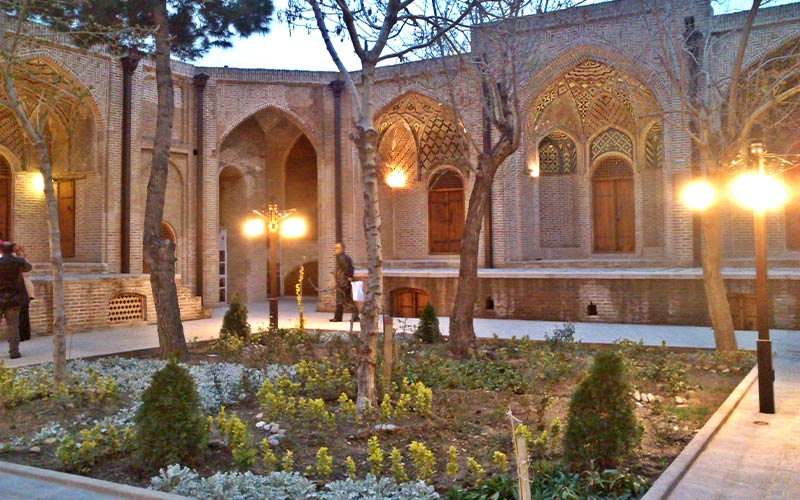
Sa'd al-Saltaneh Caravanserai is one of the most magnificent and enormous caravanserais in the whole world.
Mohammad Baqer Khan Sa'd al-Saltaneh Esfahani was the ruler of Qazvin city at the end of the reign of Naser al-Din Shah Qajar in 1892. He considered Iran's many economic relations with Russia and Turkey, so he ordered the construction of a caravanserai on a land of 2.7 hectares with about 400 rooms in the city of Qazvin. For this reason, this caravanserai became known as Sa'd al-Saltaneh Caravanserai. After about two years, it was put into operation in 1894 with the efforts of two architects from Isfahan and two from Qazvin.
Before the First World War, the Sa'd al-Saltaneh Caravanserai was regarded as the city's economic and commerce hub. However, once the Russian government underwent political upheavals, it lost its status as an economic link between Europe and Asia and was reduced to a semi-active state.
Sa'd Al-Saltaneh Caravanserai Time Period
This caravanserai was built in 1894 and dates back to Iran's Qajar era.
16. Yazd Moshir Caravanserai Hotel
Location: Yazd province, Yazd city, Emamzade Jafar Blvd., Mosalla St., Moshir ol-Mamalek bazaar.
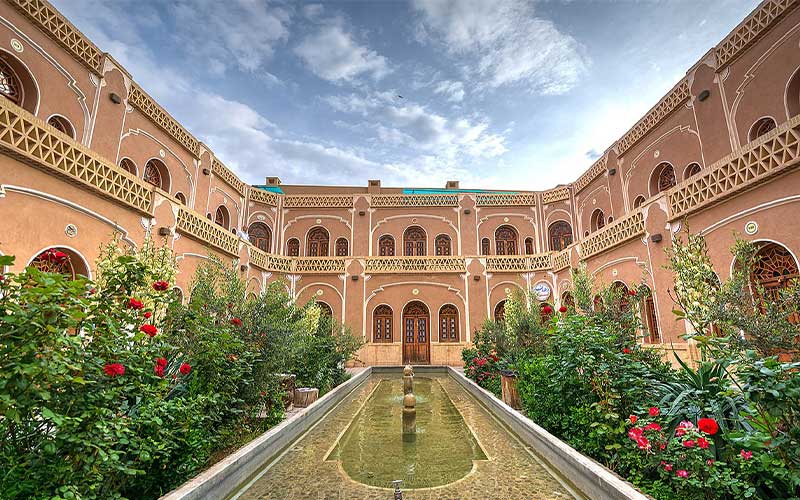
Perhaps you will only believe that such a stunning and old structure can exist once you visit Yazd Moshir Caravanserai.
One of the historical architectural landmarks of Iran is the Moshir Yazd Caravanserai Hotel. The historic and ancient city of Yazd, was constructed by Fathollah Moshir al-Mamalek during the reign of Mozaffareddin Shah Qajar. Previously a rest stop for weary travelers, Moshir Yazdan Caravanserai is now a stunning and attractive hotel. For travelers, dining in the lovely and well-equipped restaurant of the Moshir Yazdan Caravanserai Hotel, with its distinctive architecture and traditional multicolored tiles, offers beautiful moments.
Yazd Moshir Caravanserai Time Period
The Moshir Yazdan Caravanserai dates back to Mozaffareddin Shah Qajar's rule, making it 150 years old. This caravanserai was rebuilt in 1996, inaugurated in 2006, and included in the list of national heritages.
17. Khajeh Nazar Caravanserai
Location: Near the Aras River and Zia ol-Molk Bridge in Jolfa City, you'll find this caravanserai.
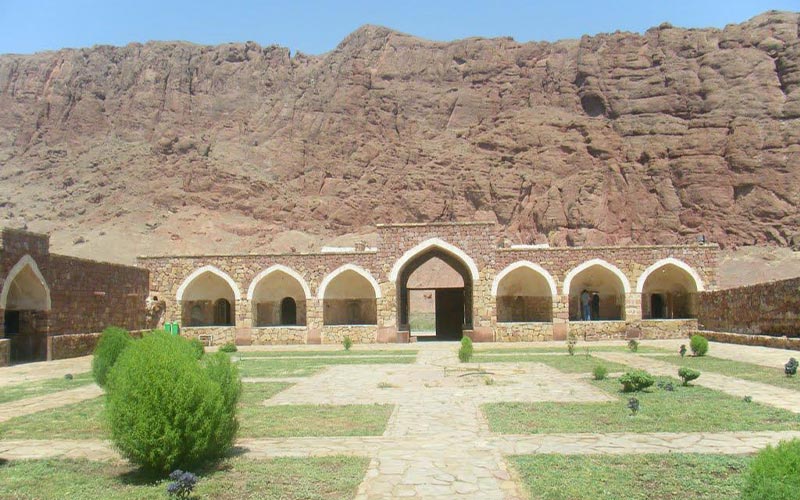
Unlike the majority of Shah Abbasi caravanserais, this structure has three porches on its three sides and a central courtyard. Dome-shaped covers with curved arches can be seen in the architecture of this building. The caravanserai, known as Khajeh Nazar, was built using brick and stone.
Today, this building hosts the living museum of Aras pottery and ceramics. It is also considered a place to hold workshops for the production, supply and display of pottery and ceramics by local artists of the region.
Khajeh Nazar Caravanserai Time Period
This building is one of the Shah Abbasi caravanserais built during the Safavid period in Iran.
18. Shah Abbasi Caravanserai of Karaj
Location: You can find this caravanserai on the southeast side of Shah Abbasi Square in Karaj, Alborz Province.
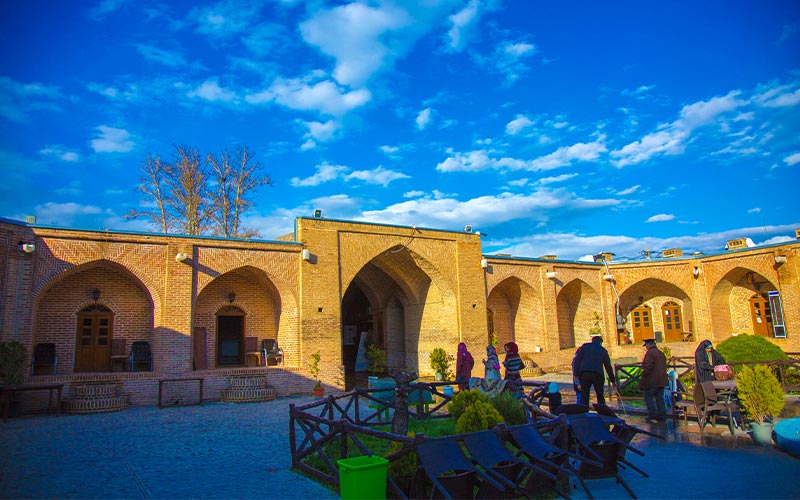
In the early years after its construction, this caravanserai was used as a resting place for caravans and their Horses, and in the early Qajar era, it became a military barracks and fortress. It was also used as a school in the late Qajar period.
The total area of the building is 3 thousand square meters, and the area of the middle yard is 900 square meters. The entrance to the caravanserai is from the north porch. There are 21 rooms with porches around the middle yard for passengers to rest and five docks for storing goods. Stone, brick, wood and thatch were used to construct this building.
Shah Abbasi Caravanserai Of Karaj Time Period
Shah Abbasi Caravanserai of Karaj belonged to the Safavid era and was built between 1667 and 1697 during the time of Shah Soleiman Safavid. The Shah Abbasi Caravanserai is considered one of the most valuable works of the Safavid period, located on the Silk Road.
19. Gaduk Caravanserai
Location: The Gaduk caravanserai is situated on Firouzkuh Road in the Gaduk region. This structure is located in a mountain pass called Gaduk or Gadik, which means pass 25 kilometers south of Versk.
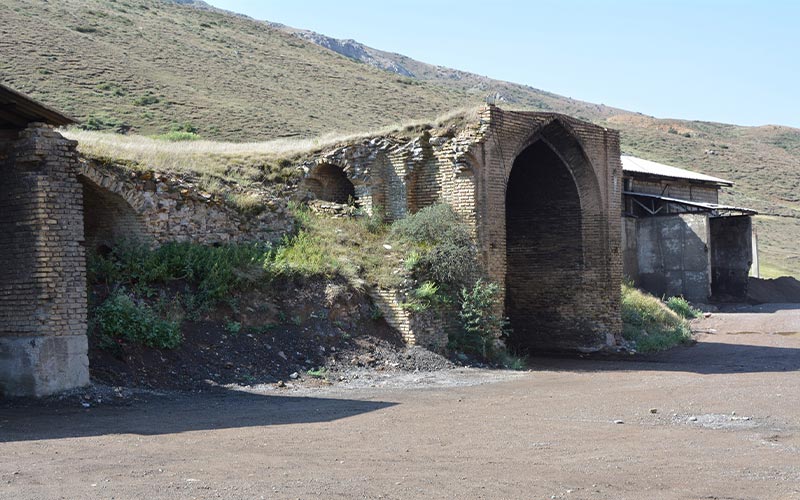
Due to the extreme weather, this caravanserai is one of the enclosed mountain caravanserais. Travelers may relax in rooms on the north and south sides of Gaduk Caravanserai. There are three separate chambers in front of the main door, which were likely the king's apartment. The building's eastern side is 50 meters long as well. One of the significant caravanserais from the Safavid era is likewise this structure.
Gaduk Caravanserai Time Period
This caravanserai, constructed in Iran during the Safavid era in 1621, has played host to significant historical events throughout the years, including the assassination of Nader Shah Afshar, Reza Shah Pahlavi's recovery, and Mohammad Ali Shah's military defeat.
20. Kenargerd Caravanserai
Location: Kanagard Caravanserai was built in the Fashafuye section of the Hasan Abad neighborhood in Shahr-e Ray city.
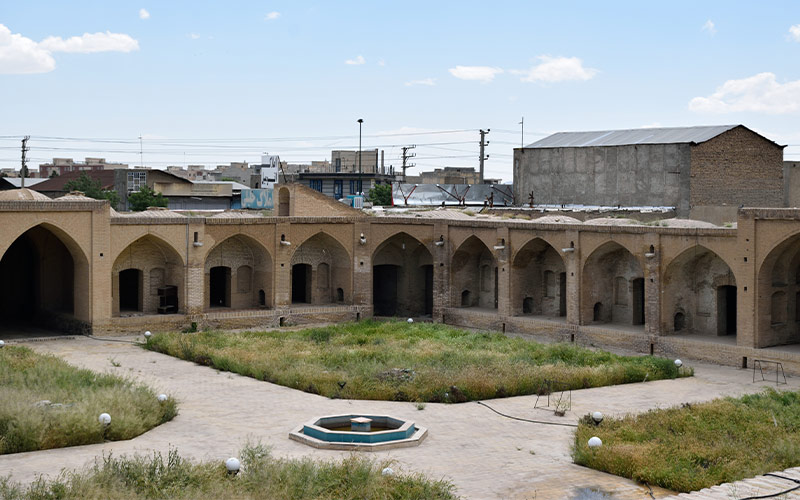
One of Shahr-e Ray city's historical landmarks is the Kenagerd caravanserai, which is currently an empty structure. This caravanserai was built with bricks, soil, and plaster, and its architectural style qualifies it as a type of caravanserai with two porches. This caravanserai was given its name since it is close to the village of Kenagerd.
The structure is divided into two sections; the eastern section is 400 years old, while the western section is only a century or so. This building's western portion was erected later.
Kenargerd Caravanserai Time Period
One of the caravanserais constructed under Shah Abbas's Safavid rule is the Kenagerd caravanserai. Therefore, this caravanserai dates back to 400 years ago and the Safavid era.
Bottom Line
In many respects, Iran is regarded as the cradle of human civilization. The fact that ancient Iranian caravanserais are regarded as the origin of modern hotels is one of the many indications that Iran's culture is the creator of fundamental ideas in the modern human world. Caravanserais, constructed and put into use for the first time during the Achaemenid period (i.e., 2500 years ago) in Iran, can be considered the world's first hotels.
We hope you found this post informative. Which of the caravanserais introduced in this post have you visited? Please tell us what you think.


Comment
Leave a Comment